Articles
5 Ways to Get Ready for Spring in Your Kitchen and Beyond
Nothing says spring like the first pop of yellow dandelions in the yard or the initial bloom of pink tulips in the garden.
Spring feels like a fresh start as seeds are germinating, bird songs return and leaves grow back on the trees. The temperatures are warmer—or maybe just less cold—and you naturally feel a bit more energy and begin to crave more fresh foods.
This year, the official start of spring is on March 20, or the spring equinox in the Northern Hemisphere. The term equinox comes from the Latin words for “equal night,” aequus (equal) and nox (night), meaning the length of day and night is about equal.
This new season may also bring about feelings of renewal. You may want to soak up extra sunshine and reconnect with friends and family.
Chilean poet Pablo Neruda wrote, “You can cut all the flowers but you cannot keep spring from coming.”
It’s important to prepare for this transition away from hibernating and heavier foods so that you can thrive in spring. Let’s talk about some of the ways you can get ready for the season starting with food.
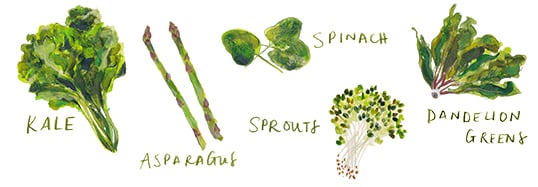
1. Go green and lighten up.
In Ayurveda, eating a seasonal diet and adapting seasonal lifestyle habits is encouraged.
Spring invites a little extra lightness and heat into our lives, which can support your physiology in its natural process of springtime revitalization.1
“Coming out of winter, it’s common to feel a heavy weightiness from overindulging in sugar, coffee, starches and convenient comfort foods,” writes Dr. Mark Hyman, bestselling author and the Head of Strategy and Innovation of Cleveland Clinic’s Center for Functional Medicine, in a blog post.2 “These foods bring balance to the cold, dreary days of winter.”
He recommends eating more leafy greens and non-starchy vegetables to help provide you the nutrition your body needs right now. “Spring is the kapha time of year, which means that the earth and water elements are taking over, otherwise known as mud season,” writes Erin Casperson, director of the Kripalu School of Ayurveda, in a blog post.3
From an Ayurvedic point of view, she says that spring is the time of year to eat lean. She also recommends eating a plethora of greens.
“Your plate should be just as green as the fluorescent-green spring landscape,” she writes.
Some green vegetables that are in season this time of year include artichoke, asparagus, beet greens, dandelion greens, leeks, kale, spinach and sprouts.
In addition, fruits to favor in the springtime include apples, apricots, cherries, lemons, limes and strawberries.
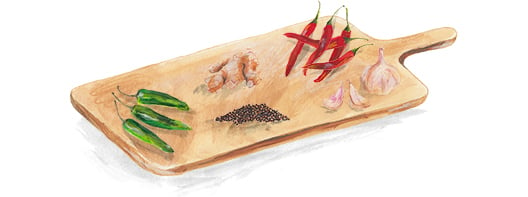
2. Add more spice.
Spicy foods may help the body transition out of winter. Hong Kong-based Chinese medicine practitioner Cecilia Cheung Po-wan told the South China Morning Post that as the winter season ends, the sun is needed to melt the snow and to evaporate the dampness in the environment.4 The same, she says, applies to our bodies.
“We eat spicy foods to dry out our system after a few months of dampness,” she said.
Traditional Chinese Medicine (TCM) teaches that spring is a great time to eat spicy food. Of course, you can determine what chilies or spices work best for your body. If jalapeños or cayenne peppers are hard for you to tolerate, try adding spices like black pepper, ginger or garlic to your meals.
You can certainly add heat to your juices as well like in this spring recipe, The Spicy Dandelion.
Science agrees that spicy foods have healthy benefits. In a 2015 study, researchers from the Harvard School of Public Health found that people who ate spicy foods almost every day had a 14-percent lower risk of death than people who ate spicy foods only once a week.5
“Some evidence from other studies suggests the bioactive ingredients in spicy foods such as capsaicin may lower ‘bad’ cholesterol and triglycerides and improve inflammation,” said study author Dr. Lu Qi.

3. Go easy with exercise.
Again, with more sunshine and warmer temps, it’s great to get outside—just be mindful as you move.
As the seasons change, our bodies are also feeling that transition and you don’t want to shock your system. Be sure to take time to warm up the body with gentle, low-impact exercises like yoga, stretching or walking.
According to Ayurveda the best time to exercise is in the morning between 6 a.m. and 10 a.m., as it helps wake you up and start your day.6 The next best time is in the early evening, before dinner.
Movement is so important for your overall health so don’t get stuck on a specific time, just move your body when you can, and do what feels good.
Also, don’t give up if you only have a small window of time for movement, as just 15 minutes of exercise can make a positive impact on how you feel.7
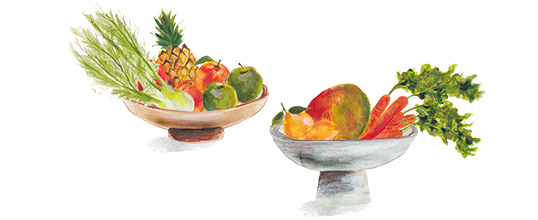
4. Spring clean the kitchen.
When was the last time you cleaned out the produce drawers in your fridge or dusted the cabinets in your pantry? Spring is a great time for freshening up throughout the house and in your kitchen.
You can start by taking everything out of the fridge, freezer and pantry to clean all the shelves and drawers. Before putting everything back, especially those sticky condiments, check the expiration dates and toss anything that’s expired or that you haven’t used in the last year. You can also check your supplements to refresh them too.
Another spring project is to get your kitchen tools in order. You can sharpen knives, refresh dish towels or go through that one drawer with all the gadgets to see if you still use everything in there.
If you don’t already have a big, beautiful bowl for keeping fresh produce on the counter, maybe now is the time to treat yourself. This trick can help you eat (or juice) more fruits and veggies, as you will naturally eat more of what you see on the counter.
A diet rich in fruit and vegetables is also associated with less stress, according to a 2021 Australian study.8
“We found that people who have higher fruit and veggie intakes are less stressed than those with lower intakes, which suggests diet plays a key role in mental well-being,” said lead researcher Simone Radavelli-Bagatini from Edith Cowan University’s Institute for Nutrition Research. “Long-term and unmanaged stress can lead to a range of health problems including heart disease, diabetes, depression and anxiety, so we need to find ways to prevent and possibly alleviate mental health problems in the future.”
Once your clean out is complete, add some fresh flowers to your kitchen or consider keeping some fresh herbs in a windowsill to help bring more life inside the house.
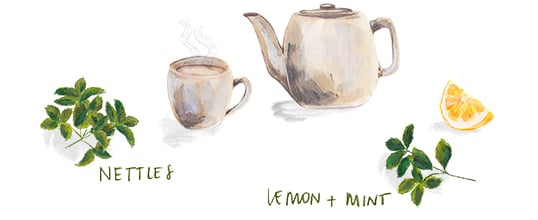
5. Enjoy wild spring foods.
Spring is an incredible time to get outside and forage. Wild edible plants are full of good-for-you nutrition and always a seasonal choice.
You can start in your own backyard, as long as you don’t spray any pesticides, with dandelions. The entire plant is edible including the flowers, young green leaves and the roots. You can use the greens to make pesto or add them to a juice. Add flowers to your favorite pancake batter for a special spring treat!
Another wild green that you might find in your backyard or a nearby sunny field are stinging nettles. You’ll want to wear gloves when you harvest them as their leaves can sting. Nettles are a great source of both minerals and vitamins. They are also known as a home remedy to help alleviate symptoms of seasonal allergies.
Once harvested, you can gently boil the leaves to get rid of their sting and add them to anything from a stir fry to a smoothie. You can make a fresh nettle tea by adding about a dozen leaves and any other fresh herbs like mint or lemon balm to a teapot. Pour hot water in the pot and let it steep for at least 10 minutes before serving.
One edible spring flower to appreciate is a violet, known for its beautiful purple hue. Violets prefer shaded areas and often grow by stream banks. The leaves are heart-shaped, and each flower usually has five petals. You can add these flowers to salads or to any juice.
Ramps, also known as wild leeks, are a great find in early spring. Usually found in wooded areas, one of the easiest ways to identify these green plants is by their smell. They have a distinct garlic aroma, which makes them perfect for topping on pizzas or to add to soups and pesto.
This wild plant has gained so much popularity that it’s important to discuss overharvesting. Never take more than you can use and treat the patch you’re harvesting from with respect so that the ramps can reproduce.
If you are new to foraging, consider taking a class or joining a local meet-up with an experienced guide. Many local restaurants will include wild foods on their menu, which is another great way to sample these natural delights. If you’re already familiar with some of the wild plants in your area, then now is a great time to incorporate them into your meals.
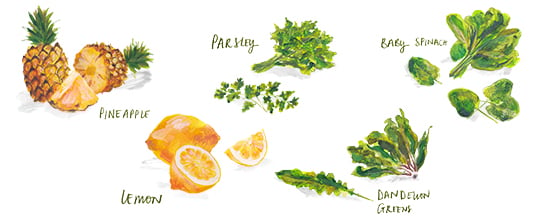
Our Favorite Produce Available in March
Here’s our guide to some of the best seasonal fruits and vegetables this month. Remember: seasonal foods will vary depending on where you live, soil conditions and weather.
BEST SPRING FRUITS

PINEAPPLE
The peak season for these tropical fruits begins in March, which means this is when these succulents will taste the sweetest. Pineapples are packed with nutrients including vitamin C and bromelain, a protein-digesting enzyme that has been demonstrated to show anti-inflammatory properties.9
• Shopping Tip: Look for healthy green fronds—the tall, spiky leaves at the top of the fruit. One way to tell if a pineapple is ripe is to gently pull a frond and if it easily comes out, that’s a good sign. Ripe pineapples also smell a little bit sweet and should have a little give when you squeeze them.
• Storage Tip: Unlike other fruits, pineapples don’t continue to ripen after harvest, so it’s best to enjoy them as soon as you can after you bring them home. If you need more than a few days, chop it up and freeze it.

LEMON
Lemons are what add a little bit of “zest” and “zing” to any juice or culinary dish. You may not realize it but there are many different varieties of lemons including variations in taste, shape and color. One of the most interesting varieties is Buddha’s hand, which resembles a lemon with long, finger-like segments. This citrus contains no fruit or pulp, but it’s extremely fragrant, and both the peel and rind are edible.
• Shopping Tip: Look for lemons without any soft spots or bruises with vivid color. A ripe lemon will have a little bit of give when squeezed.
• Varieties: Buddha’s hand, Eureka, Lisbon, Pink, Meyer
• Storage Tip: Even though lemons look pretty on the counter and can usually last a few days there, they will last longer if you store them in the produce drawer in your fridge.
BEST SPRING GREENS

DANDELION GREENS
Often overlooked as an annoying weed in your yard, dandelion greens are a nutritional powerhouse. One cup of dandelion greens contains almost twice as much iron as spinach, and over 500 percent of your daily intake of vitamin K, according to Michigan State University Extension.10 They are also rich in other minerals such as calcium, magnesium and potassium.11
• Shopping Tip: Smaller younger greens will be less bitter tasting than larger, more mature leaves.
• Juicing Tip: A little dandelion goes a long way in juices, as they tend to have a more bitter flavor. You’ll want to pair these greens with sweeter fruits like apple or pineapple.

PARSLEY
Once used mainly as a garnish, those in the know have upgraded their relationship with this green Mediterranean herb. Parsley has a long history of helping treat conditions like high blood pressure, allergies and inflammatory diseases.12 It’s no surprise as this culinary herb is full of vitamins A, C and K, plus folate.13
• Shopping Tip: Look out for the two main varieties: flat leaf and curly. Make sure the leaves are sturdy and colorful.
• Storage Tip: Keeping parsley fresh can be tricky. One of the best ways to preserve it is to wrap the herb bundle in a damp paper towel, then seal it in a bag and store it in your refrigerator.

BABY SPINACH
You’ve probably seen this little leafy green in salads or sold in bags at the store, but what exactly qualifies as baby spinach? Turns out it’s all about timing. Baby spinach is a term used to describe young spinach that has been harvested during the early stages of plant growth. These smaller leaves are generally more tender and offer a sweeter flavor than “older” spinach. And it’s full of vitamins and minerals such as vitamins A, C, K1, folic acid, iron and calcium.14
• Shopping Tip: To avoid plastic bags or clamshells, look for fresh spinach whenever you can. And if you are buying a bag of it, be sure to look for fresh, crisp leaves and watch out for limp, slimy or yellowing leaves.
• Storage Tip: Gently wrap baby spinach in a paper towel to absorb any excess water, as moisture speeds up the decaying process. You can also freeze spinach. Just place whole spinach leaves in a freezer bag and they will stay fresh for up to a year.
sources:
- https://www.banyanbotanicals.com/info/ayurvedic-living/living-ayurveda/seasonal-guides/spring-guide
- https://drhyman.com/blog/2015/05/01/food-bites-with-dr-hyman-spring-cleaning
- https://kripalu.org/resources/how-eat-spring-according-ayurveda
- https://www.scmp.com/lifestyle/health-wellness/article/3128425/why-spring-best-time-spicy-food-and-you-dont-have-be
- https://www.health.harvard.edu/nutrition/spicy-foods-associated-with-longer-life-harvard-researchers-find
- https://www.banyanbotanicals.com/info/ayurvedic-living/living-ayurveda/health-guides/the-ayurvedic-approach-to-fitness
- https://www.eatthis.com/effects-exercising-15-minutes-per-day
- https://www.sciencedaily.com/releases/2021/05/210513100030.htm
- https://www.ncbi.nlm.nih.gov/pmc/articles/PMC538506
- https://www.canr.msu.edu/news/five_ways_to_eat_dandilions
- https://fdc.nal.usda.gov/fdc-app.html#/food-details/169226/nutrients
- https://pubmed.ncbi.nlm.nih.gov/24374449
- https://fdc.nal.usda.gov/fdc-app.html#/food-details/170416/nutrients
- https://www.sciencedirect.com/science/article/pii/B9780123746283000256
- Choosing a selection results in a full page refresh.
- Press the space key then arrow keys to make a selection.




